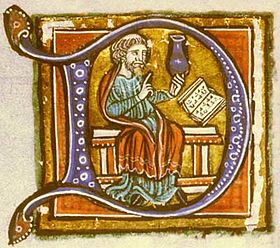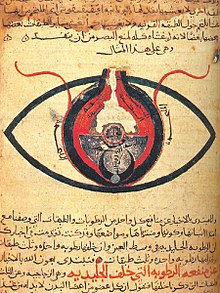حنين بن اسحاق
| ||||
|---|---|---|---|---|
 | ||||
| معلومات شخصيه | ||||
| الميلاد | سنة 808 [1][2][3][4][5] | |||
| الوفاة | سنة 873 (64–65 سنة)[7][8][1][9][10][11][12] | |||
| مواطنه | ||||
| الديانه | نسطوريه [13][14] | |||
| ابناء | اسحاق بن حنين [7] | |||
| الحياه العمليه | ||||
| اتعلم عند | يوحنا بن ماسويه [15] | |||
| المهنه | دكتور ، ومؤرخ | |||
| اللغات المحكيه او المكتوبه | عربى [16]، والسريانية [17]، وفارسى [16]، ولغه يونانى قديم [16] | |||
| مجال العمل | طب [18]، وعلم [18]، وفلسفه [18] | |||
| تعديل مصدري - تعديل | ||||
حنين بن اسحاق كان فيلسوف و مترجم و دكتور من عصر العباسيين.
حياته[تعديل]
حنين بن اسحاق من مواليد سنة 808 فى الحيره.

هوأبو زَيْد بن إسحاق العِبَادى المعروف بحُنَيْن بن إسحاق العِبَادى كان عالم ومترجم وعالم لغات وطبيب عربي،[19][20][21][22][23][24] مسيحى نسطورى.[25][26] أصله من الحيرة اتولد سنة 810م، ابوه كان بيشتغل بالصيدلة علمه اللغات.[27] كمان هو مؤرخ ومترجم ويعد من كبار المترجمين فى ذلك العصر، وكان يجيد - بالإضافة للعربية - السريانية والفارسية واليونانية. قام بترجمة أعمال جالينوس وابوقراط وارسطو والعهد القديم من اليونانية، وقد حُفظت بعض ترجماته: أعمال جالينوس وغيره من الضياع.
وفاته[تعديل]
حنين بن اسحاق مات سنة 873.
لينكات برانيه[تعديل]
- حنين بن اسحاق – صور وتسجيلات صوتيه و مرئيه على ويكيميديا كومونز
- حنين بن اسحاق معرف مخطط فريبيس للمعارف الحره
- حنين بن اسحاق معرف ملف المرجع للتحكم بالسلطه فى WorldCat
- حنين بن اسحاق معرف النظام الجامعى للتوثيق
- حنين بن اسحاق معرف جران منشورات الموسوعه الكتالانيه
- حنين بن اسحاق المعرف المعيارى الدولى للاسماء
- حنين بن اسحاق خدمه المكتبه الوطنيه
- حنين بن اسحاق ليبريس-مسار
- حنين بن اسحاق معرف اتحاد مكتبات البحوث الاوروبيه
- حنين بن اسحاق معرف القاموس الوطنى لاسماء المؤلفين
مصادر[تعديل]
- ↑ أ ب مُعرِّف موسوعة بريتانيكا على الإنترنت (EBID): https://www.britannica.com/biography/Hunayn-ibn-Ishaq — باسم: Hunayn ibn Ishaq — تاريخ الاطلاع: 9 اكتوبر 2017 — العنوان : Encyclopædia Britannica
- ↑ http://www.mcnbiografias.com/app-bio/do/show?key=johannitius
- ↑ مُعرِّف موسوعة بروكهوس على الإنترنت: https://brockhaus.de/ecs/enzy/article/hunain-ibn-ishak-al-ibadi — باسم: Hunain Ibn Ishak al-Ibadi
- ↑ باسم: Hunain — معرف شخص في المكتبة الصحية بين الجامعات: https://www.biusante.parisdescartes.fr/histoire/biographies/index.php?cle=63753
- ↑ أ ب ت باسم: Hunain — معرف شخص في المكتبة الصحية بين الجامعات: https://www.biusante.parisdescartes.fr/histoire/biographies/index.php?cle=63753 — المخترع: جون أوكونور و إدموند روبرتسون المرجع غلط: وسم
<ref>غير صالح؛ الاسم "6ddba9745c61aed5f408b43b8b430b317e2f26a4" معرف أكثر من مرة بمحتويات مختلفة. - ↑ Encyclopaedia of Islam و Encyclopédie de l’Islam — المؤلف: عدة مؤلفين
- ↑ أ ب المؤلف: آرثر باري — العنوان : A Short History of Astronomy — الناشر: جون موراي
- ↑ مُعرِّف الملف الاستنادي المُتكامِل (GND): https://d-nb.info/gnd/119239418 — تاريخ الاطلاع: 16 اكتوبر 2015 — الرخصة: CC0
- ↑ باسم: Abū Zayd Ḥunayn ibn Isḥāq — مُعرِّف دليل المكتبة الوطنيَّة السويديَّة - ليبيرس (LIBRIS): https://libris.kb.se/auth/106433 — تاريخ الاطلاع: 9 اكتوبر 2017
- ↑ Johannitius (808-873)
- ↑ باسم: Hunayn Ibn Ishaq Al'Ibadi — مُعرِّف المكتبة القومية البرتغالية (PTBNP): http://id.bnportugal.gov.pt/aut/catbnp/1260103
- ↑ مُعرِّف الاتحاد الروماني للمكتبات العلمية: http://koha-urbs.reteurbs.org/cgi-bin/koha/opac-authoritiesdetail.pl?marc=1&authid=386071 — باسم: Ḥunayn ibn Isḥāq al-ʻIbādī
- ↑ https://journals.openedition.org/asr/1652?lang=en
- ↑ https://journals.openedition.org/asr/1652?lang=en — المؤلف: Dominique Urvoy — العنوان : Les penseurs libres dans l'islam classique — الصفحة: 72
- ↑ المؤلف: عدة مؤلفين — العنوان : Encyclopaedia of Islam — المجلد: 3 — الصفحة: 578-579
- ↑ مُعرِّف الضَّبط الاستناديِّ في قاعدة البيانات الوطنية التشيكية (NLCR AUT): https://aleph.nkp.cz/F/?func=find-c&local_base=aut&ccl_term=ica=osd20201073961 — تاريخ الاطلاع: 1 مارس 2022
- ↑ مُعرِّف الضَّبط الاستناديِّ في قاعدة البيانات الوطنية التشيكية (NLCR AUT): https://aleph.nkp.cz/F/?func=find-c&local_base=aut&ccl_term=ica=osd20201073961 — المؤلف: عدة مؤلفين — العنوان : Encyclopaedia of Islam — المجلد: 3 — الصفحة: 578
- ↑ مُعرِّف الضَّبط الاستناديِّ في قاعدة البيانات الوطنية التشيكية (NLCR AUT): https://aleph.nkp.cz/F/?func=find-c&local_base=aut&ccl_term=ica=osd20201073961 — تاريخ الاطلاع: 7 نوفمبر 2022
- ↑
{{cite web}}: Empty citation (help) - ↑
{{cite web}}: Empty citation (help) - ↑ Esposito, John L. (2000). The Oxford History of Islam. Oxford University Press. p. 160.:"The most famous of these translators was a Nestorian (Christian) Arab by the name of Hunayn ibn Ishaq al-Ibadi (808–73)."
- ↑ Porter, Roy (2001). The Cambridge Illustrated History of Medicine. Cambridge University Press. p. 67."The major ninth-century medical figure in Baghdad was a Christian Arab, Hunain ibn Ishaq, an amazingly accurate and productive scholar, who traveled to the Greek Byzantine empire in search of rare Galenic treatises."
- ↑ Corbin, Henry (2014). History Of Islamic Philosophy. Routledge. p. 16.:"The latter was succeeded by one of his students, the famous and prolific Hunayn ibn Ishaq (194/ 809—260/ 873), who was born at al-Hirah into a family belonging to the Christian Arab tribe of the 'Ibad."
- ↑ Grmek, Mirko D.; Fantini, Bernardino (1998). Western Medical Thought from Antiquity to the Middle Ages. Harvard University Press. p. 145.:"Hunayn ibn Ishaq was able to satisfy their needs. Of Christian Arab descent, he had spent many years of his life in Byzantine territory, in pursuit of his studies, most probably in Constantinople."
- ↑ Ohlig, Karl-Heinz; Puin, Gerd-R. (2010). The hidden origins of Islam: new research into its early history. Prometheus Books. p. 32. :"The 'Ibad are tribes made up of different Arabian families that became connected with Christianity in al-Hira."
- ↑
{{cite web}}: Empty citation (help):"Ḥira became renowned for its literate population of Arab Christians, or ʿEbād [al-Masiḥ] “devotees [of Christ].” " - ↑
{{cite book}}: Empty citation (help)
| ||||
|---|---|---|---|---|
حنين بن اسحاق فى المشاريع الشقيقه
 صور و ملفات صوتيه من كومنز
صور و ملفات صوتيه من كومنز




